 AGRICULTURE AGRICULTURE |
The Liberian agricultural sector has continued to be one of the strong pillars on which the economy finds equilibrium. Prior to the civil conflict, the agricultural sector, including forestry, in 1987 contributed about 37.2 % of the GDP and provided employment for about 75 % of the labor force. This sector also contributed about 25 % of the country's export earnings basically from rubber and logs as the major commodities.
The agricultural sector, second only to the mining industry of predominantly iron ore in pre-conflict era, has boomeranged to become the leading contributor to the national economy in the post-conflict setting. Total agricultural output in 1999 accounted for 76 % of the GDP as compared to 37.2 % in 1987, official statistics shows.
The leading commodities making such profound impact in this sector are rubber and logs, although the sector comprises other cash crops like cocoa, coffee, and oil palm farms scattered across the countryside.
Plagued by low investment, antiquated technology and poor marketing, credit and research facilities, the agriculture sector yearns for capital infusion to increase aggregate output and improve the overall economic performance of the sector.
"Agriculture is very key to anything that happens in this country for the mere fact that over 70 % of our people are involved in this sector," says Agriculture Minister, Mr. Roland Massaquoi. Even more important, he says, is the fact that the sector is renewable.
 Rubber industry Rubber industry |
The world's largest industrial rubber plantation is in Liberia, making rubber by far the most important cash crop in the country. Liberia has been associated with rubber programs and development for the past 70 years starting from 1923 when an American company Firestone first made the decision to grow rubber in Liberia and was granted one million acres under a concession.
Today, there are about 400,000 acres of rubber that includes concession rubber, representing 40-45 %, and the remaining 55 %, small holders' rubber. Tens of thousands have benefited from employment in this industry.
In 1988, under Liberia's foreign trade performance, rubber accounted for US$106.5million, representing some 24.1 %, and interestingly bounced back in 1999 to generate US$32.2million in foreign trade and a whooping 64 % of export in 1999.
At the moment, much of the rubber shipped from the country is raw, unprocessed or semi-processed, something that negatively impacts on prices on the international market. So what? The Liberian government envisages improving the quality of the exported rubber wherein a manufacturing plant can be established in the country to add value in terms of finished products.
To this end, the government has reached a decision to establish a "standard basic agreement" for concessionaires within the rubber industry applicable to all in terms of meeting the same requirement for operating in the rubber sub-sector.
The standard basic agreement, if ratified by parliament, stipulates that existing concessions would cede a certain portion of their raw material at prevailing international market price to any entity that comes to the country to establish a processing facility to make finished products.
This approach in no way deprives the rubber concessions of their right to setting up their own processing or manufacturing plants in Liberia for the purpose of creating additional employment, adding value to Liberian rubber and broadening the national government's own revenue base.
With this approach, potential investors can run a rubber products manufacturing plant in Liberia without owning a rubber plantation or estate! This could be likened almost to the large concessions tapping into the 55 % small holders' rubber production.
"Our future is rubber and so we have a vision to expand our rubber to one million acres in the next 20 years," Agriculture Minister, Mr. Massaquoi says in no uncertain terms.
To do this, Mr. Massaquoi says the government is encouraging existing concessions to expand their present plantations, as some have already agreed to do.
"We want people to intervene in this sector. We have the land and we have laws that would allow you to acquire the land through concession to do business," Minister R. Massaquoi guarantees. He cited the Firestone Plantations Company that requested one million acres 70 years ago and had their request approved as well as a Malaysian group that has gotten some 600,000 acres approved by government for their concession.
"We want to provide an atmosphere that you can bring your capital… we can provide you some land to make the best use of it … grow something that you can export… provide employment and contribute to the social establishment in terms of Medicare and education. That is the way we want partnership in terms of economic activity," the Agriculture Minister explains in outlining the government's plan.
 Forestry Forestry |
Liberia has about 45 % of the tropical rain forest in the Upper Guinea Region consisting of five West African states and is rated one of the "hot spots" in the world in terms of its untapped forest resources. The potential of the country's forest reserves in terms of timber production is put at 10,000 to 15,000 cubic meters per square kilometers on a closed forest area of around 2.4million hectares.
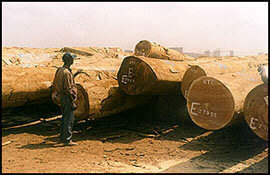
The forestry sub-sector has always been a major source of capital infusion into the national economy, and has attracted the most foreign direct investment (FDI) in Liberia since 1997 following democratic elections that ushered in the current government.
For example, the forestry sector accounted for 56.6million USD of the national revenue in 1987, but registered about 77million USD in 1999 as its contribution to the post-conflict economic growth performance.
In the pre-conflict era, Liberia produced approximately 1.1million cubic meters of logs per annum, an export quota it is striving to maintain, but in terms of doing finished products like plywood or sawn timber for added value.
Already, Oriental Timber Corporation (OTC), a Far Eastern-Liberian joint venture in the forestry sector is working a three-million-acre forest in the southeast of the country under a 50million USD investment package that provides employment today for 1,500 Liberians.
By the time the joint venture completes its plywood mill worth 60million USD in April 2001, its overall investment would be an astounding 150million USD, says its President, Mr. Gus Kouwenhoven.
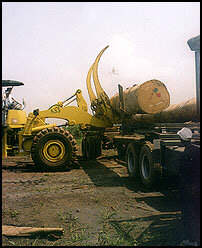
The plywood mill that would employ another 2,000-man workforce would have a production capacity of about 50-60,000 cubic meters per month and may well be one of the leading facilities of its kind on the African continent.
Africa with its vast tropical rain forest is still being supplied wood-derived-commodities such as plywood from the Far East and South America, necessitating the need to tap into a market from the continent itself and counting on proximity to save cost in market accessibility.
Concession opportunities abound in the forestry sector in the west, northwest, northeast and southeast of the country.
"Our economy depended on the iron ore sector which is not renewable for nearly 60 years. Now the agriculture and forestry sectors which have the renewable elements will be the mainstay of our economic program," the Agriculture Minister says.
Notwithstanding, policies intended to stimulate agricultural productivity, accelerate recovery and ultimately achieve sustainable development would be considered along with their short, medium and long-term effects on the environment, the government maintains. | 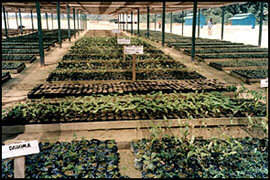
"We have to replenish, maintain our forest, utilize sustainable management methods in terms of extraction, exploitation as well as ensure reforestation programs at the community levels and in the concession areas," Minister Massaquoi insists.
OTC, the country's single most largest logging concession, is heeding government's position on reforestation, introducing and planting in the year 2001 alone some 200,000 fast growing species that could be ready for harvest in about seven years reaching a diameter of over 60cm.
Mr. Kouwenhoven sees two major benefits in a sophisticated reforestation program. One is to meet the national requirement set up by the Forestry Development Authority (FDA) as well as the rules and regulations of the international organizations, and two, one ends up with a plantation-like forest that is organized and easy to harvest.
 Cocoa and coffee Cocoa and coffee |
Plantations of cocoa and coffee, once leading cash crops in Liberia, lie idle awaiting full revitalization and the recreation of marketing mechanisms that would create incentives for the farmers. The two crops, grown mainly by smallholder farmers, constituted the economic source for farmers in rural Liberia for many years.
But the Liberian government's new approach to augmenting the productive capacity of the farmers and boosting the economic and financial benefits from this sector lies in the concept of setting up concessions, like in the areas of rubber, fisheries, logging, etc.
"We need to now find investors who are willing to come and do concession work like acquiring land to do cocoa and coffee as a means of expanding this sector," says the Liberian Agriculture Minister.
Government is willing to give the land under concession arrangements as part of its overall agro-sector development plan under which the cultivation of some one to two million acres of land in cocoa and coffee is a major component.
Under the concession concept, according to Agriculture Minister, Roland Massaquoi, the government envisages the creation of a major concession in a region of the country that would serve as a satellite or core entity from which technology transfer can reach the farmers.
These entities would then be the sole purchasers of the products of the small farmers, process them and hence add value to attract better price on the international market. Of course, he says, the government is more than willing to relinquish its monopoly on purchasing cocoa and coffee through the state-owned Liberia Produce Marketing Corporation.
Mr. Massaquoi likens this approach to the one being used currently in the country by more than four large rubber concessions which help upgrade the small-holder farmers in terms of inputs to ensure high yields, and subsequently become the sole buyers of the farmers' produce.
In 1987 cocoa beans registered 6 million USD on the foreign trade charts, while coffee netted some 10million USD at the same period. Today, the two cash crops have dropped to an all-time low due to the lack of adequate investment, grossing 2 USD and 700,000 USD in 1999 respectively.
In the 1970s the Liberian government operated a joint venture with the East Asiatic Company (EAC) for over 15 years in the cocoa and coffee business, recording the highest export rating in the two commodities ever.
"We think that at this point you can establish maybe three or four franchises for intervening in the cocoa and coffee area. And this could be done where land could be provided these franchises, perhaps, on a regional basis, to provide subsidy, intervention, technical support and extension services to the small farmers in terms of production, harvesting, processing and so forth," Minister Massaquoi said.
These franchises are encouraged to make inquiries and request subsidy from government in terms of tax grace and other incentives because they assume the responsibility to provide the level of stability within the region, the Agriculture Minister assured.
But there would have to be supervisory boards of sorts to review standards and quality as well as ensure that the farmers get prices consistent with the dynamics of the international market scales.
"We want to go beyond these small holder farms to establish medium scale and large scale farms. And then those small farms that don't have the capability to export, process to maintain quality and standard can sell their produce to an entity that has the comparative advantage and expertise in processing to add value so their overhead based on their efficiency is reduced," Minister Massaquoi opines.
Currently, there are at least four government-owned coffee, cocoa and oil palm estates set up with the aid of the World Bank and other multilateral donor agencies in the northwest, central, northeast and southeast of the country that are in dire need of revitalization, having matured a long time ago.
Liberia has the appropriate soil, climate and water requirement for the cultivation of cocoa, coffee, oil palm and many other crops, as evidence by the abundance of these crops throughout the land.
 Tertiary crops Tertiary crops |
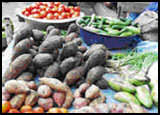
"Foreign companies (would) have to look at new areas and at agriculture in particular. Liberia has a very fertile land for commodities like rubber, coffee, cocoa and tropical fruits," notes Mr. Jamal A.H. Basma, Chairman of Africa Motors, a well and long established company involved in many aspects of the country’s development.
No doubt, the richness of the Liberian soil can allow for the cultivation of numerous other crops on a large scale to supply the local demand and reach the export market. Cashew, pineapple, peanut, cassava, plum, orange, banana, plantain and a variety of vegetables and spices have been proven to grow and flourish in Liberia.
Problem is these crops have not been grown on a plantation-like farm or for industrial purposes. Secondly, even for the small farmers' production, post-harvest losses have swallowed up the excesses that could otherwise have been processed and preserved for a market always waiting.
For instance, there exists a 6,000 acres plantation of sugar cane with a factory in the southeastern-most part of the country under the Liberia Sugar Corporation (LIBSUCO). This facility yearns for capital infusion to revitalize and begin production of the quality sugar that comes from Liberian canes.
These non-traditional cash crops hold a great deal of potential as can be vividly seen during harvest season on the farms and the market places.
"Anything you stick into the ground here in Liberia can grow," notes Mr. Gus Kouwenhoven, President of OTC, the multi-million-dollar timber corporation that has started rice production for its 1,500 employees. The rice would be harvested three times a year.
But The Haddad Group of Companies, which controls a 70% market share on imported rice, has a long-term eye on the production of the commodity locally. Rice is the staple food of Liberia's population three million.
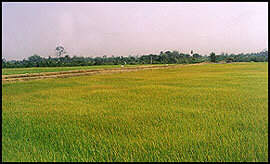
The undertaking, however, is capital intensive, requiring between 7-10million USD, according to Mr. George Haddad, President and Managing Director of the Haddad Group of Companies.
"Figures show that if you make the proper investment in the first two years, it will be very profitable. From an economic standpoint, it is a very good project," Haddad, who imports about 60,000 tons of rice a year, explains. |

